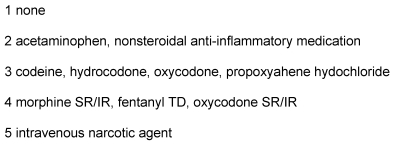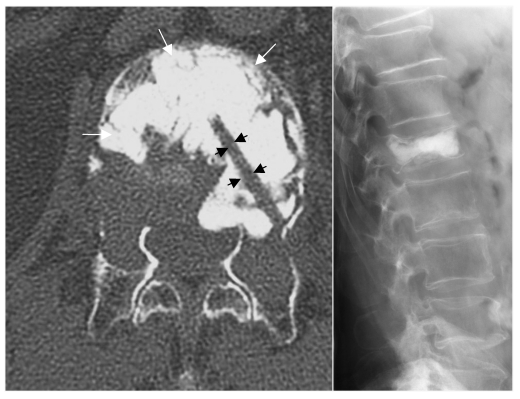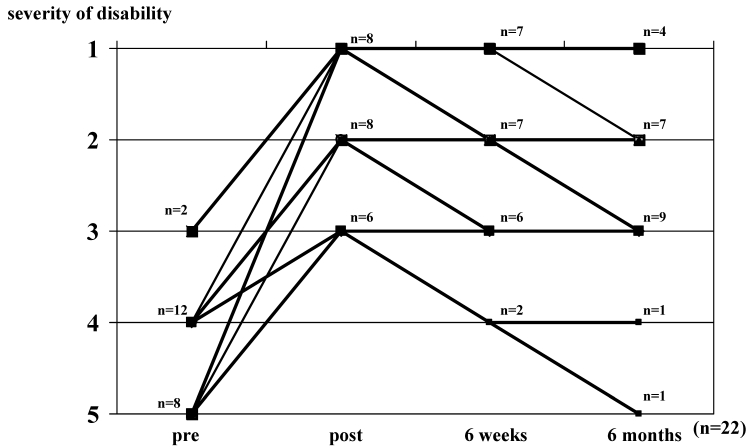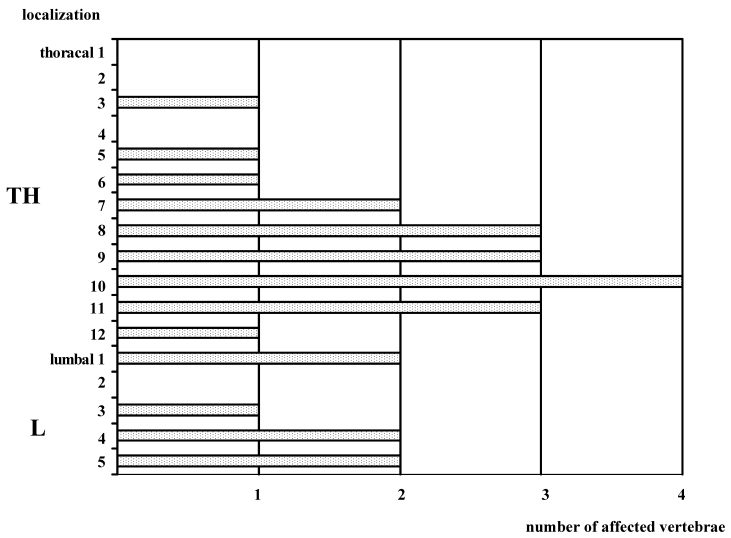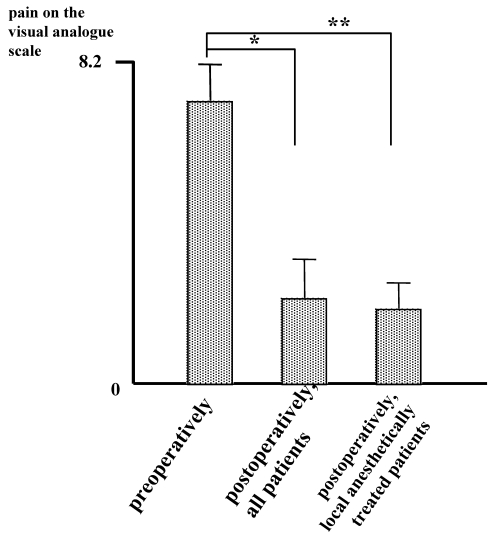Abstract
Object: Patients with osteolytic metastases frequently suffer from serious local and radicular pain. Pathophysiologically, local pain arises from skeletal instability, whereas radicular pain originates from compression of nerve roots by local tumor growth. Causal treatment of osteolytic metastases in disseminated malignant disease is very difficult. Resection of vertebrae, in combination with ventro-dorsal stabilization, is a complex treatment for patients with a limited life expectancy. Percutaneous polymethylmethacrylate (PMMA) vertebroplasty is a new and easy method of relieving patients' pain. In addition, it is both cost effective and safe. Pain is reduced immediately after treatment. Due to the regained vertebral stability, early mobilization of the patients is possible.
Methods: A total of 22 patients with osteolytic malignancies of the thoracic and lumbar spine were treated with PMMA vertebroplasty. Prior to and after surgery, then six weeks and six months after discharge from hospital, patients answered the Oswestry Low Back Pain Disability (OLBPD) Questionnaire for assessment of treatment-related change in disability. Percutaneous vertebroplasty was performed in a total of 19 patients. In three patients with tumor related compression of nerve roots an open neurolysis was performed followed by vertebroplasty.
Results: A total of 86% of patients reported a significant pain reduction. Vertebroplasty was highly beneficial for patients with pain related to local instability of the spine, but less so in patients with additional nerve root compression. Extravasation of PMMA beyond the vertebral margins was observed in 23% of the cases. No treatment-related clinical or neurological complications were seen.
Conclusions: PMMA vertebroplasty is a useful and safe method of pain relief for patients with malignant osteolytic diseases of the thoracic and lumbar spine.
Keywords: 9011-14-7, Polymethyl Methacrylate
Abstract
Einleitung: Patienten mit osteolytischen Metastasen leiden häufig an Schmerzen zweier Qualitäten: den lokalen und den radikulären Schmerz. Pathophysiologisch kann der lokale Schmerz auf die knöcherne Instabilität zurückgeführt werden, wohingegen der radikuläre Schmerz aus der Kompression der Nervenwurzeln durch lokales Tumorwachstum resultiert. Eine Kausaltherapie osteolytischer Metastasen, die Ausdruck der disseminierten Aussaat einer malignen Erkrankung sind, ist schwierig. Die Resektion von Wirbeln in Kombination mit einer ventro-dorsalen Stabilisation ist für diese Patienten mit sehr begrenzter Überlebenszeit ein komplexes Behandlungsverfahren. Die perkutane Polymethylmetacrylat (PMMA) Vertebroplastie ist eine neue und einfache Methode die Schmerzen der Patienten zu vermindern. Zusätzlich ist sie kostengünstig und komplikationsarm. Der Schmerz wird unmittelbar nach Anwendung gelindert. Wegen der wiedergewonnenen knöchernen Stabilität ist eine frühzeitige Mobilisation der Patienten möglich.
Methoden: Insgesamt wurden 22 Patienten mit osteolytischen Malignomen der thorakalen und lumbalen Wirbelsäule mit der PMMA Vertebroplastie behandelt. Nach Aufnahme, vor sowie sechs Wochen und sechs Monate nach Entlassung beantworteten die Patienten zur Beurteilung von behandlungsbedingten Änderungen ihrer Beschwerden den Oswestry Low Back Pain Disability (OLBPD) Fragebogen. Die perkutane Vertebroplastie wurde bei 19 Patienten eingesetzt. Bei drei Patienten mit tumorbedingter Kompression von Nervenwurzeln wurde die perkutane Vertebroplastie nach offener Neurolyse vorgenommen.
Ergebnisse: Insgesamt 86% der Patienten berichteten über eine signifikante Schmerzreduktion. Die Vertebroplastie hatte einen hohen Nutzen bei Patienten mit Schmerzen, die durch eine lokale Instabilität hervorgerufen waren. Eine geringere Wirkung zeigte sich in Fällen mit zusätzlicher Nervenwurzelkompression. Der Austritt von PMMA über die Wirbelkörpergrenzen wurde bei 23% der Fälle beobachtet. Es traten keine behandlungsbedingten neurologischen Komplikationen auf.
Schlussfolgerung: Die PMMA Vertebroplastie ist eine nützliche und sichere Methode zur Schmerzlinderung bei Patienten mit osteolytischen Metastasen der thorakalen und lumbalen Wirbelsäule.
Introduction
Severe pain after compression fractures of the spine is a common medical problem. Vertebral compression fractures occur either due to mineral loss of the bone in osteoporosis, or due to vertebral destruction in benign or malignant tumors. Percutaneous vertebroplasty is a method to augment bone and to relieve the pain by the injection of polymethylmethacrylate into a collapsed vertebral body [1]. In patients with malignancies, the infiltrating tumor destroys the integrity of the vertebrae, which is followed by vertebral collapse causing severe pain. Regardless of the etiology, vertebral compression fractures yield to disabling pain in all patients. Prior to the introduction of percutaneous vertebroplasty, this pain has been treated conservatively with analgesics, bed rest and external bracing. However, these treatments provided only variable efficacy [2]. The minority of patients began to get pain relief within a few days or weeks after their fracture. The majority had severe and persistent pain for weeks or months.
Surgery is rarely considered a therapy for patients with metastatic bone infiltration. Vertebroplasty is useful for the treatment of selected patients with spinal malignancies. In general, the technique has been applied to patients with a limited life span, and those who are considered to be poor surgical candidates. Vertebroplasty may be performed to provide pain reduction, spinal stabilization, or both. Extensive osteolysis particularly involving the posterior vertebral cortex may lead to a leakage of the material used for vertebroplasty into the spinal canal. As a result spinal cord or nerve root compression may occur. In contrast to benign compression fractures, the treatment of neoplastic lesions often requires modification of the techniques used for vertebroplasty. Combination of vertebroplasty with post treatment irradiation is possible and useful.
The advantage of vertebroplasty for treatment of neoplastic disease was supported in a previous series. Weil et al. [3] reported a clear improvement of pain in 24 (73%) of 33 procedures in a series of patients treated for metastatic lesions by vertebroplasty. In five patients (14%) they observed minor complications, all related to cement extravasation. Three patients developed radicular pain. In a follow up study on 37 patients "marked pain relief" was noted in 22 (59%) cases. Extra-vertebral cement leakage was detected by CT in 29 of the 40 treated vertebrae. In almost all cases, the leaks were small and had no clinical relevance [4]. Comparing the treatment of benign osteoporotic fractures with vertebral malignancies, vertebroplasty has similar results with regards to pain relief. However, complications were more frequent in patients with malignancies. This study was conducted to test the hypothesis that the reduction of pain after percutaneous vertebroplasty is an immediate and long lasting phenomenon that is highly beneficial for patients with malignant osteolytic processes in the spine.
Methods
Between January and July 2002 patients with osteolytic malignancies of the thoracic and lumbar spine without neurological deficits were included into the study. The main indication for treatment was pain.
Preoperatively, an intensive diagnostic workup was performed in all patients including spinal MRI for detection of tumor extension, localization, infiltration of the spinal canal and paravertebral tissue; spinal CT of the affected vertebrae for evaluation of paravertebral infiltration and bony destruction and a conventional x-ray of the affected spinal region.
The degree of metastatic infiltration of the vertebral bodies was quantified by the Tokuhashi scoring system [5].
Life quality questionnaire
For assessment of changes in quality of life after vertebroplasty all patients received the Oswestry Low Back Pain Disability Questionnaire before, two days, six weeks and six months after vertebroplasty [6]. This questionnaire is divided into ten sections assessing back pain related limitations of various activities of the daily life. Each section contains six statements. The patient marks the one statement in each section which describes his limitation most accurately. Each section is scored on a 0-5 scale, 5 representing the greatest disability. The scores for all sections added together, give a possible score of 50. If a section is not completed because it is inapplicable, the final score is adjusted to obtain a percentage. The validity and reliability of the questionnaire was proofed by several studies [7], [8], [9]. A 5-step disability score was used to group the percentage results (Tab. 1). Results from the pre- and post-treatment questionnaire were compared.
Table 1. Five step quantification of the results of Oswestry Low Back Pain Disability Questionnaire.
Pain assessment
Two additional pain scales were used. The visual analogue scale was used to estimate the patients' pain perception prior to, two days, six weeks and half a year after vertebroplasty. This scale with a range of 0-10 is a standard method in pain analysis. 0 stands for no pain, 10 for intolerable pain.
All patients receiving local anesthesia for vertebroplasty were additionally asked about their comfort levels during the operation procedure. A five step scale was used immediately after treatment. The scale was defined as follows:
1. no problems
2. short lived and well tolerable pain
3. moderate pain
4. distinct pain during the procedure
5. intolerable pain.
Patients, who received general anesthesia for surgical neurolysis followed by vertebroplasty were excluded from this part of analysis.
Analgesic medication
Preoperatively most patients received an analgesic combination regime for pain treatment. Changes in analgesia after vertebroplasty were assessed using a 5 step classification (Tab. 2).
Table 2. Grading of analgesic drug usage.
Treatment procedure
Bilateral vertebroplasty was performed in the operating room using fluoroscopy. All patients, except those with segmental pain related to tumor compression of nerve roots, were treated under local anesthesia with Xandicain 1%. Midazolam was given as mild sedation, if needed.
Patients with additional radicular pain were treated in general anesthesia.
During positioning on the operating table, attention was paid to upholster the kyphotic or lordotic spinal malalignment.
Needle placement for percutaneous vertebroplasty was performed using standard fluoroscopy (Siremobil 2000, Siemens Erlangen, Germany).
A commercially available kit was used for vertebroplasty (Stryker Coorporation, Jersey City, NJ, U.S.A.). The kit contains needles, 1 and 3 cc syringes for injection, and a vacuum-assisted cement mixing device, as well as a package of Howmedica Surgical Simplex P™ cement.
The pedicles were identified under anterior-posterior (AP), bilateral oblique and lateral view. An approach directly lateral of the pedicles was used to minimize the risk of spinal cord or nerve root injury. Bilaterally, the vertebral body was punctured with a 13 gauge needle. After fluoroscopic control with contrast medium (Solutrast, 2cc, Byk Gulden, Germany) PMMA was injected into the damaged vertebrae. In a post treatment CT-scan the access for vertebral body puncture is shown (Fig. 1).
Figure 1. Computed tomography of vertebral body L1 after vertebroplasty.
Arrows mark the puncture canal for PMMA injection. The white staining marks the PMMA inside the vertebral body. Small picture on the right: post-treatment X-ray
Three hours after the vertebroplasty procedure, patients were allowed to get up and walk without additional external orthesis.
Data analysis
Mean +/-SEM values were calculated and statistical analysis was performed using students t-test and Wilcoxon test for paired values. Statistical significance was accepted for p<0.05.
Results
Twenty-two patients with secondary malignancies of the thoracic and lumbar vertebral column were examined. The mean age of the patients was 59.5 ± 1.9 years. The male to female ratio was 2.1:1. The diagnosis of vertebral metastasis was made after back pain prompted a radiological diagnostic in all patients.
Back pain was the sole indication for treatment in this study. No patient showed a tumor related neurological deficit. Mostly, terrible pain related to body movement limited the mobility of the patients. Three patients were immobilized continuously due to pain at every movement of their body. Further five patients rested mainly in bed because of unforeseeable pain attacks during walking. Twelve patients were categorized into the group of severe disability, whereas two patients showed only moderate disability.
In two cases of pulmonary cancer and in one of prostate cancer additional radicular pain was observed besides back pain. These three patients were grouped in the bed rest group (Fig. 4), (Tab. 1). MRI in all three patients showed local nerve root compression by the tumor in combination with osteolytic destruction of two vertebral bodies and pedicles. These three patients with infiltration of the neighboring vertebrae were first treated by hemilaminectomy and local tumor removal for surgical neurolysis. Vertebroplasty followed subsequently as a second step during the same general anesthesia.
Figure 4. The Oswestry Low Back Pain Disability Questionnaire.
Disability before and after vertebroplasty. All patients improved significantly after the procedure.
Histology
The primary tumor was histologically confirmed in all patients. Primary tumor sites were lungs, prostate and breasts in 50%, 27% and 18% of patients, respectively. One patient (5%) had a spinal compression due to a plasmocytoma in a vertebrae. Most of the patients received standard treatment for the primary tumor including surgery and combined radio-chemotherapy prior to vertebroplasty.
Localization
Four patients showed an infiltration of more than one vertebral body. In two of them the adjacent to L 4 and 5 and in one case the vertebral bodies of TH 10 and 11 were affected. One patient showed an infiltration of multiple vertebral bodies. Clinical symptoms were apparent for a metastasis in vertebral body of L 3. He was treated only in the symptomatic localization.
Middle and lower thoracic vertebral column was the predominant localization of metastases. A lower number of cases were observed in lumbar spine (Fig. 2).
Figure 2. Distribution of affected vertebrae in the cohort of 22 patients.
Note that 15 of 26 (58 %) of affected vertebrae are located in the lower thoracic and upper lumbar spine (Th 8-L1). None of the vertebrae were located in the cervical spine.
Pain assessment
According to the visual analog scale, the median pain value preoperatively was 6.4 (2.3 to 9.1). Two days after treatment, the visual analogue scale showed a general reduction of pain. Median pain value decreased significantly to 2.1 (0.8 to 4.6; p<0.01). Excluding the three patients from the analysis that were treated by combination of hemilaminectomy and vertebroplasty, pain improved to 1.5 (0.8 to 2.9; p<0.01) (Fig. 3).
Figure 3. Pain assessment by visual analogue scale pre- and postoperatively.
(* for P < 0.001, ** for P < 0.001, n = 22)
Immediately after vertebroplasty the patients treated under local anesthesia were asked for their discomfort during the procedure. The subjective judgment of the patients showed no major problems. Using the five step division for their "comfort" during vertebroplasty, the median strain on the whole treatment including positioning of the patient, puncture procedure and duration was 2 (range 1 to 3).
Preoperative analgesic drug usage was reduced during 24 hours after vertebroplasty. Three patients expressing minor local pain preoperatively did not receive any medication at 24 hours after vertebroplasty. One of these patients remained free of analgesic drugs at six months after vertebroplasty. Especially in patients with opioide and morphine medication drug reduction was performed carefully. At six weeks after operation the number of patients with class 3 and 4 medication was significantly reduced. No patient receiving class 4 drugs preoperatively became drugfree. But they were grouped into lower drug classes or were treated with reduced amounts of their prior medication. These circumstances explain the number of NSAID and class 2 drugs treated patients already after six months.
Additional treatment with benzodiazepine for muscle relaxation or neuroleptics was also reduced during six weeks after operation and remained on a lower postoperative level.
OLBPD-Questionnaire
The most important point of the study and main objective of the treatment was the reduction of osteolysis related vertebral pain and the improvement of the patients' quality of life. Quality of life was assessed pre- and postoperatively by the OLBPD-questionnaire. Before completing the questionnaire two days after vertebroplasty the patients had to do physical exercises like walking, climbing stairs, knee-bend and bending over. As shown in Figure 4 (Fig. 4), all patients reported a pain relief. The average improvement was 1.7 ± 0.1 steps of the disability score (p<0.01). Treatment in the subgroup of patients with local and radicular pain was less successful. Local pain improved well. However, residual radicular pain resulted in a minor improvement. Overall, Wilcoxon statistical analysis of the relief of disability showed a highly significant improvement after vertebroplasty (p<0.01). Although a slight worsening occured during the six month postoperative time, quality of life persisted on a significantly higher level than preoperatively.
Complications
Extravasation of PMMA outside the vertebral margins was defined as minor treatment complication. This complication was observed in five patients (23%). No patient developed any clinical or neurological symptoms. Further treatment related complication did not occur. Perioperative mortality was 0%.
Discussion
Summary of findings
In this study a total of 22 patients with back pain due to osteolytic metastasis of various primary tumors were treated with vertebroplasty. Overall a significant reduction of pain could be achieved. The patients tolerated the procedure well. Although the total amount of analgesic drugs was not reduced significantly, several patients were treated satisfactorily with reduced amounts of analgesics or with drugs of lower classes. The OLBPD-assessment revealed a significant reduction of pain leading to improved daily life activity and quality of life within two days after vertebroplasty. During the following six months quality of life diminished slowly but remained significantly improved.
Patients were ambulatory within three hours after the procedure. No new neurological deficits were observed and the mortality of the procedure was 0%. Therefore, the procedure is considered to be safe. The results on pain reduction and improved quality of life in combination with reduced pain medication indicate the benefit of vertebroplasty in patients with spinal metastases.
Treatment options in patients with osteolytic metastasis
Osteolytic metastases and myeloma are the most frequent malignant osteolytic lesions of the spine. Severe back pain and disability represent the major symptoms in affected patients. Mechanical pain is the predominant type of pain in patients with osteolytic metastasis. Therapeutic management depends on the number of affected vertebrae, the spinal level and the osteolytic location of the tumor within the vertebra. Epidural extension of tumor tissue in the spinal canal together with the neurological signs determines the therapeutic regimen. In general, the baseline condition of the patient sets the limitations of the therapeutic extend. The timing of the treatment is primarily determined by the severity of pain and disability.
Radiation therapy gives partial or complete relief of the pain in more than 90% of patients [10]. However, this analgesic effect is not obtained until 10-20 days after the procedure. Strengthening of osteolytic vertebra after irradiation is minimal with a high remaining risk of painful vertebral collapse [10].
Vertebrectomy and surgical reinforcement of osteolytic vertebral bodies is not practical in most patients because of the multifocal nature of the disease. Therefore, minimal invasive methods with the aim of pain release combined with a stabilizing compound will be the method of choice.
The immediate analgesic effect of vertebroplasty can be explained by a so called "in situ immobilization" of vertebral body fracture. Pathophysiologically, the cement is inserted into the bone and stabilizes the bone immediately. In addition, the polymerisation heat may destroy pain fibers in the bone itself.
Indications for vertebroplasty
Clinical appearance
The best results are seen in patients who complain of a severe, focal, and mechanical back pain, requiring bed rest and major analgesic drugs, related to a neoplastic vertebral collapse without epidural involvement [11]. In a study on 37 patients with osteolytic metastases pain decreased in 97.3% of patients [12]. In a two years follow-up narcotic and analgesic drug usage decreased by 63% [13]. In our study focal pain during movement represented the best indication for vertebroplasty.
The indications for vertebroplasty and open surgery are different. Decompression of spinal canal and nerve roots are main goals of surgical therapy. A combination of the two methods may be indicated if vertebroplasty facilitates surgery. Vertebroplasty provides an anterior stabilization of the vertebral column that may avoid an anterior surgical approach. If necessary posterior surgical stabilization can be performed with smaller orthesis following dorsal decompression.
Radiological appearance
The vertebral collapse must not be complete. In case of an osteolysis with a high risk of vertebral collapse, it is indicated to perform vertebroplasty already in asymptomatic metastatic vertebral body lesions in order to prevent the collapse [11]. The amount of cement inserted does not correlate with the reduction of pain [4]. There is no reason for a complete filling of the lesion. It is better to avoid a leakage of cement with the risk of cord compression, especially in extensive cortical osteolytic lesions. The amount of PMMA used in this study ranged between 3 and 6 ml.
Vertebroplasty and adjacent therapies
Radiotherapy should be performed after vertebroplasty. Radiation therapy does not interfere with the mechanical properties of PMMA [14]. Additionally, irradiation complements the analgesic effect of vertebroplasty.
Vertebroplasty seems to have an antitumoral effect. This can explain the low number of cases of local recurrence even if vertebroplasty is not completed by irradiation. The antitumoral effect may be explained by the local toxicity of PMMA and the heat of polymerisation and ischemia induced by the injection of cement in a limited tumoral tissue volume [15], [16], [3].
Complications of vertebroplasty
In general, more complications are reported after vertebroplasty of malignant lesions than of osteoporotic fractures [3]. Most complications are due to leakage of cement, in cases of cortical osteolysis. The use of a relatively viscous cement mixture may prevent leakage in this situation [17], [4], [18]. Needle placement should be guided by the particular anatomy of each specific lesion. In general, anterior needle placement is desirable so that the cement is injected as far from the spinal canal as possible. Multiple needle placements and separate cement injections may be necessary to fill the vertebral body adequately without compromising of the spinal canal or the neural foramen. The goal of cement injection is to provide adequate support for the anterior column. The complication rate for vertebroplasty in malignant spinal lesions is 10% [11]. Three types of acute symptoms can be observed: increased pain not associated with cement leak, radiculopathy, and spinal cord compression. Radiculopathy is the major complication of vertebroplasty with a risk of 4% [11]. The thoracic and lumbar transpedicular approach of the vertebral body avoids leaks into the external part of the neural foramina along the needle track and the risk of radiculopathy [11]. In osteolytic vertebral collapse and narrow pedicles of thoracic vertebral column, an approach immediately lateral to the pedicle will provide additional safety in order to avoid opening of the spinal canal or damaging of a nerve root. Vertebroplasty under local anesthesia should be considered for the treatment of patients with osteolytic vertebral collapse [19], [18]. Awake patients allow the clinical detection of neurological symptoms during the injection. In our study under local anesthesia, patients tolerated the procedure well and reported only little pain. None of the patients canceled the procedures due to intolerable pain.
Conclusions
Percutaneous vertebroplasty developed by Galibert et al. [1] as treatment option for patients with malignant destruction of the thoracic and lumbar vertebral column provides fast pain relief by in situ immobilization of destroyed vertebra. Painless mobilization immediately after treatment restores the patients' quality of life and allows early discharge from the hospital.
Acknowledgements
We are thankful to Dioni Rovello-Freking, RN, NP University of California Los Angeles, UCLA Medical Center for a critical review and language editing of the paper.
References
- 1.Galibert P, Deramond H, Rosat P, Le Gars D. Note préliminaire sur le traitement des angiomes vertébraux par vertebroplastie acrylique percutanée. Neurochirurgie. 1987;33:166–168. [PubMed] [Google Scholar]
- 2.Cortet B, Cotton A, Boutry N, Flipo RM, Duquesnoy B, Chastanet P, Delcambre B. Percutaneous vertebroplasty in the treatment of osteoporotic vertebral compression fractures: an open prospective study. J Rheumatol. 1999;26:2222–2228. [PubMed] [Google Scholar]
- 3.Weil A, Chiras J, Simon JM, Rose M, Sola-Martinez T, Enkaoua E. Spinal metastases: indications for and results of percutaneous injection of acrylic surgical cement. Radiology. 1996;199:241–247. doi: 10.1148/radiology.199.1.8633152. [DOI] [PubMed] [Google Scholar]
- 4.Cotton A, Dewatre F, Cortet B, Assaker R, Leblond D, Duquesnoy B, Clarisse J. Percutaneous vertebroplasty for osteolytic metastases and myeloma: effects of the percentage of lesion filling and the leakage of methyl methacrylate at clinical follow-up. Radiology. 1996;200:525–530. doi: 10.1148/radiology.200.2.8685351. [DOI] [PubMed] [Google Scholar]
- 5.Tokuhashi Y, Matsuzaki H, Toriyama S, Kawano H, Ohsaka S. Scoring system for the preoperative evaluation of metastatic spine tumor prognosis. Spine. 1990;15:1110–1113. doi: 10.1097/00007632-199011010-00005. [DOI] [PubMed] [Google Scholar]
- 6.Fairbank JCT, Couper J, Davis JB, O´Brien JP. The Oswestry low back pain disability questionnaire. Physiotherapy. 1980;66:271–273. [PubMed] [Google Scholar]
- 7.Airaksinen O, Herno A, Turunen V, Saari T, Suomlainen O. Surgical outcome of 438 patients treated surgically for lumbar spinal stenosis. Spine. 1997;22:2278–2282. doi: 10.1097/00007632-199710010-00016. [DOI] [PubMed] [Google Scholar]
- 8.Frost H, Lamb SE, Klaber-Moffett JA, Fairbank JC, Moser JS. A fitness programme for patients with chronic low back pain: 2-year follow-up of a randomised controlled trial. Pain. 1998;75:273–279. doi: 10.1016/s0304-3959(98)00005-0. [DOI] [PubMed] [Google Scholar]
- 9.Little DG, MacDonald D. The use of the percentage change in Oswestry Disability Index score as an outcome measure in lumbar spinal surgery. Spine. 1994;19:2139–2143. doi: 10.1097/00007632-199410000-00001. [DOI] [PubMed] [Google Scholar]
- 10.Shepherd S. Radiotherapy and the management of metastatic bone pain. Clin Radiol. 1988;39:547–550. doi: 10.1016/s0009-9260(88)80234-4. [DOI] [PubMed] [Google Scholar]
- 11.Deramond H, Deprister C, Gailbert P, Le Gars D. Percutaneous vertebroplasty with polymethylmethacrylat. Technique, indications, and results. Radiol Clin North Am. 1998;36:533–546. doi: 10.1016/s0033-8389(05)70042-7. [DOI] [PubMed] [Google Scholar]
- 12.Cortet B, Cotton A, Boutry N, Dewatre F, Flipo RM, Duquesnoy B, Chastanet P, Delcambre B. Percutaneous vertebroplasty in patients with osteolytic metastases or multiple myeloma. Rev Rheum Engl Ed. 1997;64:177–183. [PubMed] [Google Scholar]
- 13.Amar AP, Larsen DW, Esnaashari N, Albuquerque FC, Lavine SD, Teitelbaum GP. Percutaneous transpedicular polymethylacrylate vertebroplasty for the treatment of spinal compression fractures. Neurosurgery. 2001;49:1105–1115. [PubMed] [Google Scholar]
- 14.Murray JA, Bruels MC, Lindberg RD. Irradiation of polymethylmethacrylate. In vitro gamma radiation effect. J Bone Joint Surg Am. 1974;56:311–312. [PubMed] [Google Scholar]
- 15.Brado M, Hansmann HJ, Richter GM, Kauffmann GW. Interventionelle Therapie von primären und sekundären Tumoren der Wirbelsäule. Orthopäde. 1998;27:269–273. doi: 10.1007/s001320050230. [DOI] [PubMed] [Google Scholar]
- 16.Chiras J, Depriester C, Weill A, Sola-Martinez MT, Deramond H. Vertebroplasties percutanées. Technique et indications. J Neuroradiol. 1997;24:45–59. [PubMed] [Google Scholar]
- 17.Barr JD, Barr MS, Lemley TJ, McCann RM. Percutaneous vertebroplasty for pain relief and spinal stabilization. Spine. 2000;25:923–928. doi: 10.1097/00007632-200004150-00005. [DOI] [PubMed] [Google Scholar]
- 18.Martin JB, Jean B, Sugiu K, San Millan Ruiz D, Plotin M, Murphy K, Rufenacht B, Muster M, Rufenacht DA. Vertebroplasty: clinical experience and follow-up results. Bone. 1999;25 (2 Suppl):11S–15S. doi: 10.1016/s8756-3282(99)00126-x. [DOI] [PubMed] [Google Scholar]
- 19.Bostrom MP, Lane JM. Future directions. Augmentation of osteoporotic vertebral bodies. Spine. 1997;22 (24 Suppl):38S–42S. doi: 10.1097/00007632-199712151-00007. Erratum in: Spine 1998;23:1922. [DOI] [PubMed] [Google Scholar]




